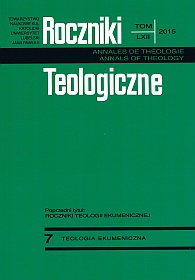Interpretation of the Church as Communion in the Document The Church: Towards A Common Vision
Abstract
This article deals with the interpretation of the Church as communion as presented in the document The Church: Towards a Common Vision, of the “Faith and Order” Commission. After a short presentation of the stages of the Commission’s work that contributed to the emergence of the ecclesiological category of communion, the meaning of this category in the document is described. This begins with the definition of the Church as communion. This definition indicates three interrelated dimensions of ecclesial communion: with the Triune God, in the life of the community of believers and in its mission. Subsequently the most important aspects of these three dimensions are described from an ecumenical perspective. The Church is a mysterious reality of the saving communion between man and the Triune God. Therefore, in the life of the Church it means to move towards eschatological fullness, by growing in essential elements of visible communion: faith, sacramental life, ministry and mission in the world. The mission of the Church is interpreted as introducing communion in a world that is marked by divisions and brokenness because of sin. Primarily, it consists of inviting all people to accept the salvation in Jesus Christ, followed then by its commitment to the social and moral struggles of all humanity and to promotion of the unity of creation. Throughout, important ecumenical issues are considered as a whole with their possible interpretation in the perspective of communion.
References
[The] Church: Towards a Common Vision. Faith and Order Paper No. 214. Geneva 2013.
Confessing the One Faith. An Ecumenical Explication of the Apostolic Faith as it is confessed in the Nicene-Constantinopolitan Creed (381). Faith and Order Paper No. 153. Geneva 1991.
[The] Gift of Authority. Authority in the Church III. An Agreed Statement by the Anglican-Roman Catholic International Commission, London 1999.
Inter-Orthodox Consultation for a Response to the Faith and Order Study: The Nature and Mission of the Church. A Stage on the Way to a Common Statement, Cyprus, 2011, 19-20, https://www.oikoumene.org/en/press-centre/news/NapaReport.pdf (dostęp: 14.07.2014).
Jedność Kościoła jako koinonia: dar i powołanie. Dokument Siódmego Zgromadzenia Ogólnego Światowej Rady Kościołów w Canberze (1991). „Studia i Dokumenty Ekumeniczne” 9:1993 nr 1 s. 72-74.
Katechizm Kościoła Katolickiego. Poznań 2002.
Komisja „Wiara i Ustrój” Światowej Rady Kościołów: Chrzest, Eucharystia, posługiwanie duchowne. W: Chrzest, Eucharystia, posługiwanie duchowne. Dokument z Limy 1982. Tekst i komentarze. Red. W. Hryniewicz, S.J. Koza. Lublin 1989 s. 15-63.
Komisja „Wiara i Ustrój” Światowej Rady Kościołów: Natura i misja Kościoła. Etap na drodze ku wspólnemu oświadczeniu (2005). Tłum. R. Nehring. „Studia i Dokumenty Ekumeniczne” 26: 2010 nr 1 s. 66-108.
Międzynarodowa Komisja Mieszana do Dialogu Teologicznego między Kościołem rzymskokatolickim a Kościołem prawosławnym: Konsekwencje eklezjologiczne i kanoniczne sakramentalnej natury Kościoła, Rawenna 2007. „Sympozjum” 16:2012 nr 1 s. 117-132.
[The] Nature and Purpose of the Church: A Stage on the Way to the Common Statement, Faith and Order Paper No. 181. Geneva 1998.
Piąta Światowa Konferencja do spraw Wiary i Ustroju Kościoła. Santiago de Compostela, Hiszpania, 3-14 sierpnia 1993 r.: Orędzie. Ku pełniejszej koinonia. „Studia i Dokumenty Ekumeniczne” 10:1994 nr 1 s. 89-92.
Piąta Światowa Konferencja do spraw Wiary i Ustroju Kościoła. Santiago de Compostela, Hiszpania, 3-14 sierpnia 1993 r.: Raport Sekcji I. Koinonia jako dar i powołanie. „Studia i Dokumenty Ekumeniczne” 10:1994 nr 1 s. 74-81.
Piąta Światowa Konferencja do spraw Wiary i Ustroju Kościoła. Santiago de Compostela, Hiszpania, 3-14 sierpnia 1993 r.: Raport Sekcji II. Koinonia w wierze apostolskiej. „Studia i Dokumenty Ekumeniczne” 10:1994 nr 1 s. 82-89.
Piąta Światowa Konferencja do spraw Wiary i Ustroju Kościoła. Santiago de Compostela, Hiszpania, 3-14 sierpnia 1993 r.: Raport Sekcji III. Udział we wspólnym życiu w Chrystusie. „Studia i Dokumenty Ekumeniczne” 10:1994 nr 2 s. 49-58.
Piąta Światowa Konferencja do spraw Wiary i Ustroju Kościoła. Santiago de Compostela, Hiszpania, 3-14 sierpnia 1993 r.: Raport Sekcji IV. Powołani do dawania wspólnego świadectwa dla odnowionego świata. „Studia i Dokumenty Ekumeniczne” 10:1994 nr 2 s. 58-68.
Sobór Watykański II: Dekret o działalności misyjnej Kościoła Ad gentes divinitus (7.12.1965). W: Sobór Watykański II. Konstytucje, dekrety, deklaracje. Tekst polski. Nowe tłumaczenie, Poznań 2002 s. 433-471.
Sobór Watykański II: Konstytucja dogmatyczna o Kościele Lumen gentium (21.11.1964). W: Sobór Watykański II. Konstytucje, dekrety, deklaracje. Tekst polski. Nowe tłumaczenie, Poznań 2002 s. 104-166.
Wspólna Grupa Robocza Kościoła Rzymskokatolickiego i Światowej Rady Kościołów: Kościół – lokalny i uniwersalny. Dokument studyjny (1990). „Studia i Dokumenty Ekumeniczne” 8:1992 nr 2 69-85.
Copyright (c) 2015 Roczniki Teologiczne

This work is licensed under a Creative Commons Attribution-NonCommercial-NoDerivatives 4.0 International License.





